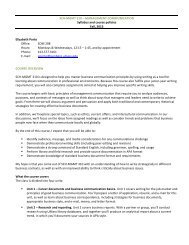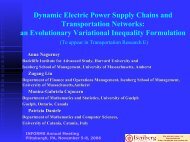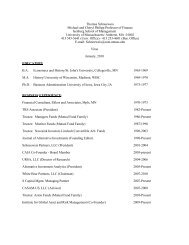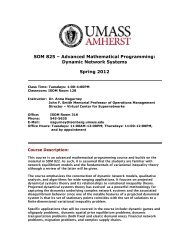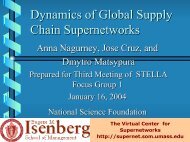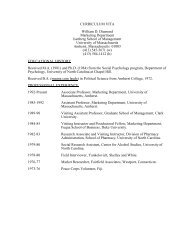An Integrated Electric Power Supply Chain and Fuel Market Network ...
An Integrated Electric Power Supply Chain and Fuel Market Network ...
An Integrated Electric Power Supply Chain and Fuel Market Network ...
You also want an ePaper? Increase the reach of your titles
YUMPU automatically turns print PDFs into web optimized ePapers that Google loves.
Introduction Literature Review <strong>Integrated</strong> <strong>Electric</strong> <strong>Power</strong> <strong>Supply</strong> <strong>Chain</strong>s Empirical Examples Conclusions<strong>Electric</strong> <strong>Power</strong> <strong>Supply</strong> <strong>Chain</strong>s (Cont’d)The U.S. electric power industry: Half a trillion dollars of netassets, $220 billion annual sales, 40% of domestic primaryenergy (Energy Information Administration (2000, 2005))DeregulationWholesale marketBilateral contract<strong>Power</strong> pool.<strong>Electric</strong> power supply chain networksVarious generation technologiesInsensitive dem<strong>and</strong>sTransmission congestionIn 2007, the total transmission congestion cost in NewEngl<strong>and</strong> was about $130 million (ISO New Engl<strong>and</strong> <strong>An</strong>nual<strong>Market</strong> Report, 2007).
Introduction Literature Review <strong>Integrated</strong> <strong>Electric</strong> <strong>Power</strong> <strong>Supply</strong> <strong>Chain</strong>s Empirical Examples ConclusionsLoad Curve
Introduction Literature Review <strong>Integrated</strong> <strong>Electric</strong> <strong>Power</strong> <strong>Supply</strong> <strong>Chain</strong>s Empirical Examples ConclusionsLoad Duration Curve
Introduction Literature Review <strong>Integrated</strong> <strong>Electric</strong> <strong>Power</strong> <strong>Supply</strong> <strong>Chain</strong>s Empirical Examples ConclusionsA Simple Example of Transmission Congestion
Introduction Literature Review <strong>Integrated</strong> <strong>Electric</strong> <strong>Power</strong> <strong>Supply</strong> <strong>Chain</strong>s Empirical Examples ConclusionsA Simple Example of Transmission Congestion
Introduction Literature Review <strong>Integrated</strong> <strong>Electric</strong> <strong>Power</strong> <strong>Supply</strong> <strong>Chain</strong>s Empirical Examples ConclusionsA Simple Example of Transmission Congestion
Introduction Literature Review <strong>Integrated</strong> <strong>Electric</strong> <strong>Power</strong> <strong>Supply</strong> <strong>Chain</strong>s Empirical Examples ConclusionsA Simple Example of Transmission Congestion
Introduction Literature Review <strong>Integrated</strong> <strong>Electric</strong> <strong>Power</strong> <strong>Supply</strong> <strong>Chain</strong>s Empirical Examples ConclusionsA Simple Example of Transmission Congestion
Introduction Literature Review <strong>Integrated</strong> <strong>Electric</strong> <strong>Power</strong> <strong>Supply</strong> <strong>Chain</strong>s Empirical Examples ConclusionsA Simple Example of Transmission Congestion
Introduction Literature Review <strong>Integrated</strong> <strong>Electric</strong> <strong>Power</strong> <strong>Supply</strong> <strong>Chain</strong>s Empirical Examples ConclusionsA Simple Example of Transmission Congestion
Introduction Literature Review <strong>Integrated</strong> <strong>Electric</strong> <strong>Power</strong> <strong>Supply</strong> <strong>Chain</strong>s Empirical Examples ConclusionsSources of <strong>Electric</strong>ity in the U.S. in 2007Source: http://www.eia.doe.gov
Introduction Literature Review <strong>Integrated</strong> <strong>Electric</strong> <strong>Power</strong> <strong>Supply</strong> <strong>Chain</strong>s Empirical Examples Conclusions<strong>Electric</strong> <strong>Power</strong> <strong>Supply</strong> <strong>Chain</strong>s <strong>and</strong> <strong>Fuel</strong> <strong>Market</strong>sIn the U.S., electric power generation accounts for significantportions of fuel dem<strong>and</strong>s30% of the natural gas dem<strong>and</strong> (over 50% in the summer)90% of the coal dem<strong>and</strong>over 45% of the residual fuel oil dem<strong>and</strong>.
Introduction Literature Review <strong>Integrated</strong> <strong>Electric</strong> <strong>Power</strong> <strong>Supply</strong> <strong>Chain</strong>s Empirical Examples Conclusions<strong>Electric</strong> <strong>Power</strong> <strong>Supply</strong> <strong>Chain</strong>s <strong>and</strong> <strong>Fuel</strong> <strong>Market</strong>s (Cont’d)The interactions between electric power supply chains <strong>and</strong> fuelmarkets affect dem<strong>and</strong>s <strong>and</strong> prices of electric power <strong>and</strong> fuels.From December 1, 2005 to April 1, 2006, the wholesaleelectricity price in New Engl<strong>and</strong> decreased by 38% mainlybecause the delivered natural gas price declined by 45%.In August, 2006, the natural gas price jumped 14% becausehot weather across the U.S. led to elevated dem<strong>and</strong> forelectricity. This high electricity dem<strong>and</strong> also caused the crudeoil price to rise by 1.6%.
Introduction Literature Review <strong>Integrated</strong> <strong>Electric</strong> <strong>Power</strong> <strong>Supply</strong> <strong>Chain</strong>s Empirical Examples Conclusions<strong>Electric</strong> <strong>Power</strong> <strong>Supply</strong> <strong>Chain</strong>s <strong>and</strong> <strong>Fuel</strong> <strong>Market</strong>s (Cont’d)The availability <strong>and</strong> the reliability of diversified fuel supplies alsoaffect national security.In January 2004, over 7000MW of electric power generation,which accounts for almost one fourth of the total capacity ofNew Engl<strong>and</strong>, was unavailable during the electric system peakdue to the limited natural gas supply.The American Association of Railroads has requested that theFederal Energy Regulatory Commission (FERC) investigatethe reliability of the energy supply chain with a focus onelectric power <strong>and</strong> coal transportation.
Introduction Literature Review <strong>Integrated</strong> <strong>Electric</strong> <strong>Power</strong> <strong>Supply</strong> <strong>Chain</strong>s Empirical Examples ConclusionsLiterature ReviewBeckmann, McGuire, <strong>and</strong> Winsten (1956): How are electricpower flows related to transportation flows?<strong>Electric</strong> power wholesale <strong>and</strong> retail marketsSmeers (1997), Hogan (1992), Chao <strong>and</strong> Peck (1996), Casazza<strong>and</strong> Delea (2003), Hobbs <strong>and</strong> Pang (2003), Borenstein <strong>and</strong>Holl<strong>and</strong> (2003), <strong>and</strong> Garcia, Campos, <strong>and</strong> Reitzes (2005), etc.<strong>Electric</strong> power markets <strong>and</strong> fuel marketsEmery <strong>and</strong> Liu (2001), Bessembinder <strong>and</strong> Lemmon (2002),Huntington <strong>and</strong> Schuler (1997), Brown <strong>and</strong> Yucel (2007), etc.
Introduction Literature Review <strong>Integrated</strong> <strong>Electric</strong> <strong>Power</strong> <strong>Supply</strong> <strong>Chain</strong>s Empirical Examples ConclusionsLiterature Review (Cont’d)A. Nagurney <strong>and</strong> D. Matsypura, “A <strong>Supply</strong> <strong>Chain</strong> <strong>Network</strong>Perspective for <strong>Electric</strong> <strong>Power</strong> Generation, <strong>Supply</strong>,Transmission, <strong>and</strong> Consumption,” in Optimisation,Econometric <strong>and</strong> Financial <strong>An</strong>alysis, E. J. Kontoghiorghes<strong>and</strong> C. Gatu, Editors (2006) Springer, Berlin, Germany, pp3-27A. Nagurney, Z. Liu, M. G. Cojocaru, <strong>and</strong> P. Daniele,“Dynamic electric power supply chains <strong>and</strong> transportationnetworks: <strong>An</strong> evolutionary variational inequality formulation,”Transportation Research E 43 (2007), 624-646D. Matsypura, A. Nagurney, <strong>and</strong> Z. Liu, “Modeling of electricpower supply chain networks with fuel suppliers via variationalinequalities,” International Journal of Emerging <strong>Electric</strong> <strong>Power</strong>Systems 8 (2007), 1, Article 5.
Introduction Literature Review <strong>Integrated</strong> <strong>Electric</strong> <strong>Power</strong> <strong>Supply</strong> <strong>Chain</strong>s Empirical Examples Conclusions“<strong>An</strong> <strong>Integrated</strong> <strong>Electric</strong> <strong>Power</strong> <strong>Supply</strong> <strong>Chain</strong> <strong>and</strong> <strong>Fuel</strong> <strong>Market</strong><strong>Network</strong> Framework: Theoretical Modeling with Empirical <strong>An</strong>alysisfor New Engl<strong>and</strong>”, Zugang Liu <strong>and</strong> <strong>An</strong>na Nagurney, 2007This paper can be downloaded at:http://supernet.som.umass.edu/dart.html.
Introduction Literature Review <strong>Integrated</strong> <strong>Electric</strong> <strong>Power</strong> <strong>Supply</strong> <strong>Chain</strong>s Empirical Examples ConclusionsContributionsThe model captures both economic transactions <strong>and</strong> physicaltransmission constraints.The model considers the behaviors of all major decisionmakers including gencos, consumers <strong>and</strong> the independentsystem operator (ISO).The model considers multiple fuel markets, electricitywholesale markets, <strong>and</strong> operating reserve markets.The model is applied to the New Engl<strong>and</strong> electric powersupply chain consisting of 6 states, 5 fuel types, 82 powergenerators, with a total of 573 generating units, <strong>and</strong> 10dem<strong>and</strong> markets.
Introduction Literature Review <strong>Integrated</strong> <strong>Electric</strong> <strong>Power</strong> <strong>Supply</strong> <strong>Chain</strong>s Empirical Examples ConclusionsThe <strong>Electric</strong> <strong>Power</strong> <strong>Supply</strong> <strong>Chain</strong> <strong>Network</strong> with <strong>Fuel</strong><strong>Supply</strong> <strong>Market</strong>s
Introduction Literature Review <strong>Integrated</strong> <strong>Electric</strong> <strong>Power</strong> <strong>Supply</strong> <strong>Chain</strong>s Empirical Examples ConclusionsEnergy <strong>Fuel</strong> <strong>Supply</strong> CurvesSource: Minerals Management Service, Gulf of Mexico Region
Introduction Literature Review <strong>Integrated</strong> <strong>Electric</strong> <strong>Power</strong> <strong>Supply</strong> <strong>Chain</strong>s Empirical Examples ConclusionsThe Equilibrium Conditions for the <strong>Fuel</strong> <strong>Supply</strong> <strong>Market</strong>sAssume that the following conservation of flow equations musthold for all fuel supply markets a = 1, . . . , A; m = 1, . . . , M:W∑G∑w=1 g=1 r 1 =1 u=1N R∑ ∑ gr1qgr am1 uw + ¯q am = h am .The (spatial price) equilibrium conditions (cf. Nagurney (1999))for suppliers at fuel supply market am; a = 1, ..., A; m = 1, ..., M,take the form: for each generating unit gr 1 u; g = 1, ..., G;r 1 = 1, ..., R; u = 1, ..., N gr1 , <strong>and</strong> at each dem<strong>and</strong> level w:{π am (h ∗ ) + cgr am = ρam∗gr 1 uw, if qgr am∗1 uw > 0,1 uw≥ ρ am∗gr 1 uw, if qgr am∗1 uw = 0.
Introduction Literature Review <strong>Integrated</strong> <strong>Electric</strong> <strong>Power</strong> <strong>Supply</strong> <strong>Chain</strong>s Empirical Examples Conclusions<strong>Power</strong> Generator’s Maximization ProblemMultiple power plantsDual-fuel power plantsRevenueBilateral contracts<strong>Power</strong> poolOperating reserve markets.Cost<strong>Fuel</strong> costOperating costTransaction costCongestion cost.
Introduction Literature Review <strong>Integrated</strong> <strong>Electric</strong> <strong>Power</strong> <strong>Supply</strong> <strong>Chain</strong>s Empirical Examples Conclusions<strong>Power</strong> Generator’s Maximization Problem (Cont’d)−W∑w=1−+W∑w=1L wW∑w=1MaximizeL wr 1 =1 u=1W∑w=1r 1 =1 u=1 r 2 =1L wN R∑ ∑ gr1 R∑ K∑r 1 =1 u=1 r 2 =1 k=1N R∑ ∑ gr1 R∑ρ ∗ r 2 w y gr 1ur 2 w +−W∑A∑M∑w=1 a=1 m=1 r 1 =1 u=1N R∑ ∑ gr1W∑f gr1 uw (q gr1 uw ) −L w−r 1 =1 u=1 r 2 =1W∑w=1 r 1 =1 u=1N R∑ ∑ gr1ρ am∗gr 1 uw qgr am1 uww=1N R∑ ∑ gr1 R∑c gr 1ur 2 w (y gr 1ur 2 w ) −W∑w=1L wr 1 =1 u=1 r 2 =1 b=1L wρ gr 1u∗r 2 kw qgr 1ur 2 kwN R∑ ∑ gr1L w ϕ ∗ r 1 w z gr1 uwN R∑ ∑ gr1 R∑ K∑c gr 1ur 2 kw (qgr 1ur 2 kw )W∑w=1r 1 =1 u=1 r 2 =1 k=1L wN R∑ ∑ gr1c gr1 uw (z gr1 uw )r 1 =1 u=1N R∑ ∑ gr1 R∑ B∑K∑µ ∗ bw α r1 r 2 b[ q gr 1ur 2 kw + y gr 1ur 2 w ]k=1
Introduction Literature Review <strong>Integrated</strong> <strong>Electric</strong> <strong>Power</strong> <strong>Supply</strong> <strong>Chain</strong>s Empirical Examples Conclusions<strong>Power</strong> Generator’s Maximization Problem (Cont’d)subject to:R∑K∑r 2 =1 k=1q gr 1ur 2 kw + R∑A∑a=1β gr1 uar 2 =1y gr 1ur 2 w = q gr1 uw , r 1 = 1, ..., R; u = 1, ..., N gr1 ; w = 1, ..., W ,M∑m=1q amgr 1 uw + L w β gr1 u0q gr1 uw = L w q gr1 uw , r 1 = 1, ..., R;u = 1, ..., N gr1 ; w = 1, ..., W ,q gr1 uw + z gr1 uw ≤ Cap gr1 u, r 1 = 1, ..., R; u = 1, ..., N gr1 ; w = 1, ..., W ,z gr1 uw ≤ OP gr1 u, r 1 = 1, ..., R; u = 1, ..., N gr1 ; w = 1, ..., W ,q gr 1ur 2 kw ≥ 0, r1 = 1, ..., R; u = 1, ..., Ngr 1; r 2 = 1, ..., R; k = 1, ..., K; w = 1, ..., W ,qgr am1 uw ≥ 0, a = 1, ..., A; m = 1, ..., M; r 1 = 1, ..., R; u = 1, ..., N gr1 ; w = 1, . . . , W ,y gr 1ur 2 w ≥ 0, r 1 = 1, ..., R; u = 1, ..., N gr1 ; r 2 = 1, ..., R; w = 1, .., W ,z gr1 uw ≥ 0,r 1 = 1, ..., R; u = N gr1 ; w = 1, ..., W
Introduction Literature Review <strong>Integrated</strong> <strong>Electric</strong> <strong>Power</strong> <strong>Supply</strong> <strong>Chain</strong>s Empirical Examples ConclusionsThe ISO’s RoleManages the power pool.Schedules transmission.Manages congestion.Ensures system reliability.
Introduction Literature Review <strong>Integrated</strong> <strong>Electric</strong> <strong>Power</strong> <strong>Supply</strong> <strong>Chain</strong>s Empirical Examples ConclusionsThe ISO’s RoleThe ISO ensures that the regional electricity markets r = 1, . . . , R clear at eachdem<strong>and</strong> level w = 1, . . . , W , that is,G∑N R∑ ∑ gr1g=1 r 1 =1 u=1y gr 1u∗rw{= ∑ R∑ Kr 2 =1 k=1 y r r∗2 kw , if ρ ∗ rw > 0,≥ ∑ R∑ Kr 2 =1 k=1 y r r∗2 kw , if ρ ∗ rw = 0.The ISO also ensures that the regional operating reserve markets; hence,r 1 = 1, . . . , R clear at each dem<strong>and</strong> level w = 1, . . . , W , that is,N G∑ ∑ gr1g=1 u=1z ∗ gr 1 uw{ = OPRr1 w , if ϕ ∗ r 1 w > 0,≥ OPR r1 w , if ϕ ∗ r 1 w = 0.The following conditions must hold for each interface b <strong>and</strong> at each dem<strong>and</strong>level w, where b = 1, . . . , B; w = 1, . . . , W :N R∑ R∑ G∑ ∑ gr1 K∑G N[ q gr 1u∗r 2 kw + ∑ ∑ gr1y gr 1u∗r 2 w +r 1 =1 r 2 =1 g=1 u=1 k=1g=1 u=1K∑k=1y r 1∗r 2 kw ]α r 1 r 2 b{ = TCapb , if µ ∗ bw > 0,≤ TCap b , if µ ∗ bw = 0.
Introduction Literature Review <strong>Integrated</strong> <strong>Electric</strong> <strong>Power</strong> <strong>Supply</strong> <strong>Chain</strong>s Empirical Examples ConclusionsThe Equilibrium Conditions for the Dem<strong>and</strong> <strong>Market</strong>sWe assume that all dem<strong>and</strong> markets have fixed <strong>and</strong> known dem<strong>and</strong>s. <strong>and</strong> thefollowing conservation of flow equations, hence, must hold for all dem<strong>and</strong>markets k = 1, . . . , K r2 , all regions r 2 = 1, . . . , R, <strong>and</strong> at all dem<strong>and</strong> levelsw = 1, . . . , W :G∑N R∑ ∑ gr1g=1 r 1 =1 u=1q gr 1u∗r 2 kw+ R∑r 1 =1y r 1∗r 2 kw = (1 + κr 2w )d r2 kw .The equilibrium conditions for consumers at dem<strong>and</strong> market k in region r 2 takethe form: for each power plant u; u = 1, ..., U r1 g ; each generator g = 1, ..., G;each region r 1 = 1, ..., R, <strong>and</strong> each dem<strong>and</strong> level w; w = 1, . . . , W :<strong>and</strong>ρ ∗ r 1 w +ρ gr 1u∗r 2 kwB∑b=1{ + ĉgr 1u = ρ∗r 2 kw (Q2∗ w )r2 kw , if q gr 1u∗r 2 kw > 0,≥ ρ ∗ r 2 kw , if q gr 1u∗r 2 kw = 0;{µ ∗ bw α r1 r 2 b + ĉ r 1 2∗ = ρ∗r 2 kw(Yw )r2 kw , if y r 1∗r 2 kw > 0,≥ ρ ∗ r 2 kw , if y r 1∗r 2 kw = 0.
Introduction Literature Review <strong>Integrated</strong> <strong>Electric</strong> <strong>Power</strong> <strong>Supply</strong> <strong>Chain</strong>s Empirical Examples ConclusionsDefinition: <strong>Electric</strong> <strong>Power</strong> <strong>Supply</strong> <strong>Chain</strong> <strong>Network</strong>EquilibriumThe equilibrium state of the electric power supply chain networkwith fuel supply markets is one where the fuel flows <strong>and</strong> electricpower flows <strong>and</strong> prices satisfy the equilibrium conditions for thefuel markets, the optimality conditions for the power generators,the equilibrium conditions for the dem<strong>and</strong> markets, <strong>and</strong> theequilibrium conditions for the ISO.
Introduction Literature Review <strong>Integrated</strong> <strong>Electric</strong> <strong>Power</strong> <strong>Supply</strong> <strong>Chain</strong>s Empirical Examples ConclusionsTheorem: Variational Inequality Formulation of the<strong>Electric</strong> <strong>Power</strong> <strong>Supply</strong> <strong>Chain</strong> <strong>Network</strong> EquilibriumThe equilibrium conditions governing the electric power supply chain network coincide with the solution of thevariational inequality given by: determine (Q 1∗ , q ∗ , Q 2∗ , Y 1∗ , Y 2∗ , Z ∗ , η ∗ , λ ∗ , µ ∗ , ρ ∗ 3 , ϕ∗ ) ∈ K 1 satisfyingW∑ A∑ M∑ G∑ R∑w=1 a=1 m=1 g=1 r 1 =1Ngr ∑1[u=1π am(Q 1∗ ) + c amgr 1 uw]× [q amgr 1 uw − qam∗ gr 1 uw ]W∑ G Ngr [∑ R∑ ∑1∂fgr1 uw (qgr ∗ + L 1 uw ) ]w+ η ∗ grw=1 g=1 r 1 =1 u=1 ∂q 1 uw × [q gr1 uw − q ∗ gr 1 uw ]gr1 uw⎡W∑ G Ngr∑ R∑ ∑1R∑ K∑+ L ww=1 g=1 r 1 =1 u=1 r 2 =1 k=1W∑ G Ngr∑ R∑ ∑1+ L ww=1 g=1 r 1 =1 u=1⎣ ∂cgr 1 ur 2 kw (qgr 1 u∗r 2 kw )⎡R∑r 2 =1∂q gr 1 ur 2 kw⎣ ∂cgr 1r u2 w (y gr 1r u∗2 w )∂y gr 1 ur 2 w+B∑b=1⎤µ ∗ bw α r 1 r 2 b + ĉ gr 1 ur 2 kw (Q2∗ w ) ⎦ × [q gr 1 ur 2 kw − qgr 1 u∗r 2 kw ]⎤B∑+ µ ∗ bw α r 1 r 2 b − ρ ∗ r 2 wb=1⎦ × [y gr 1 ur 2 w − y gr 1 u∗r 2 w ]W∑ G Ngr [∑ R∑ ∑1∂cgr1 uw (zgr ∗ + L 1 uw )]w+ λ ∗ grw=1 g=1 r 1 =1 u=1 ∂z 1 uw + η∗ gr 1 uw − ϕ∗ r 1 w × [z gr1 uw − z ∗ gr 1 uw ]gr1 uw⎡⎤W∑ ∑ R R∑ K∑+ L w⎣ρ ∗ r 1 w + ĉr 1 2∗r2(Ykw w ) + ∑ B µ ∗ bw α ⎦r 1 r 2 b × [y r 1r2 kw − y r 1 ∗r 2 kw ]w=1 r 1 =1 r 2 =1 k=1b=1
Introduction Literature Review <strong>Integrated</strong> <strong>Electric</strong> <strong>Power</strong> <strong>Supply</strong> <strong>Chain</strong>s Empirical Examples ConclusionsTheorem: Variational Inequality Formulation of the<strong>Electric</strong> <strong>Power</strong> <strong>Supply</strong> <strong>Chain</strong> <strong>Network</strong> Equilibrium (Cont’d)W∑ G Ngr∑ R∑ ∑1[+ L ww=1 g=1 r 1 =1 u=1W∑ G Ngr∑ R∑ ∑1[+ L ww=1 g=1 r 1 =1 u=1Cap gr1 u − q ∗ gr 1 uw − z∗ gr 1 uwOP gr1 u − z ∗ gr 1 uw]× [η gr1 uw − η ∗ gr 1 uw ]]× [λ gr1 uw − λ ∗ gr 1 uw ]W∑ B Ngr∑R∑ R∑ G∑ ∑1K∑+ L w [TCap b − [q gr 1 u∗ G Ngrr 2 kw + ∑ ∑1K∑y gr 1 u∗r 2 w + y r 1 ∗r 2 kw ]α r 1 r 2 b] × [µ bw − µ ∗ bw ]w=1 b=1r 1 =1 r 2 =1 g=1 u=1 k=1g=1 u=1k=1W∑ ∑ R G∑ R∑+ L w [w=1 r=1 g=1 r 1 =1Ngr 1 ∑u=1y gr 1 u∗rwR∑ K∑−r 2 =1 k=1y r∗r 2 kw ] × [ρrw − ρ∗ rw ]W∑ R Ngr∑ G∑ ∑1+ L w [ z ∗ gr 1 uw − OPRr 1 ] × [ϕr 1 w − ϕ∗ r 1 w ] ≥ 0,w=1 r 1 =1 g=1 u=1∀(Q 1 , q, Q 2 , Y 1 , Y 2 , Z, η, λ, µ, ρ 3 , ϕ) ∈ K 1 , (1)where K 1 ≡ {(Q 1 , q, Q 2 , Y 1 , Y 2 , Z, η, λ, µ, ρ 3 , ϕ)|(Q 1 , q, Q 2 , Y 1 , Y 2 , Z, η, λ, µ, ρ 3 , ϕ)∈ R AMNW +NRKW +NRW +4NW +R2 KW +BW +2RW+ <strong>and</strong> the conservation of flow equations hold}.
Introduction Literature Review <strong>Integrated</strong> <strong>Electric</strong> <strong>Power</strong> <strong>Supply</strong> <strong>Chain</strong>s Empirical Examples ConclusionsTheorem: ExistenceIf (Q 1∗ , q ∗ , Q 2∗ , Y 1∗ , Y 2∗ , Z ∗ , η ∗ , λ ∗ , µ ∗ , ρ ∗ 3 , ϕ∗ ) satisfies variational inequality (1) then(Q 1∗ , q ∗ , Q 2∗ , Y 1∗ , Y 2∗ , Z ∗ ) is a solution to the variational inequality problem: determine(Q 1∗ , q ∗ , Q 2∗ , Y 1∗ , Y 2∗ , Z ∗ ) ∈ K 2 satisfyingW∑ A∑ M∑ G∑ R∑w=1 a=1 m=1 g=1 r 1 =1Ngr ∑1[u=1π am(Q 1∗ ) + c amgr 1 uw]× [q amgr 1 uw − qam∗ gr 1 uw ]W∑ G Ngr [∑ R∑ ∑1∂fgr1 uw (qgr ∗ + L 1 uw ) ]w× [q gr1 uw − q ∗ grw=1 g=1 r 1 =1 u=1 ∂q 1 uw ]gr1 uw⎡W∑ G Ngr∑ R∑ ∑1R∑ K∑+ L ww=1 g=1 r 1 =1 u=1 r 2 =1 k=1W∑ G Ngr∑ R∑ ∑1+ L ww=1 g=1 r 1 =1 u=1⎣ ∂cgr 1 ur 2 kw (qgr 1 u∗r 2 kw )R∑r 2 =1∂q gr 1 ur 2 kw∂c gr 1 ur 2 w (y gr 1 u∗r 2 w )∂y gr 1 ur 2 w⎤+ ĉ gr 1 ur 2 kw (Q2∗ w ) ⎦ × [q gr 1 ur 2 kw − qgr 1 u∗r 2 kw ]× [y gr 1 ur 2 w − y gr 1 u∗r 2 w ]W∑ G Ngr∑ R∑ ∑1∂c gr1 uw (zgr ∗ + L 1 uw )w× [z gr1 uw − z ∗ grw=1 g=1 r 1 =1 u=1 ∂z 1 uw ]gr1 uwW∑ ∑ R R∑ K∑+ L wĉ r 1 2∗r2(Ykw w ) × [y r 1r2 kw − y r 1 ∗r 2 kw ] ≥ 0, ∀(Q1 , q, Q 2 , Y 1 , Y 2 , Z) ∈ K 2 , (2)w=1 r 1 =1 r 2 =1 k=1
Introduction Literature Review <strong>Integrated</strong> <strong>Electric</strong> <strong>Power</strong> <strong>Supply</strong> <strong>Chain</strong>s Empirical Examples ConclusionsTheorem: Existence (Cont’d)where K 2 ≡ {(Q 1 , q, Q 2 , Y 1 , Y 2 , Z)|(Q 1 , q, Q 2 , Y 1 , Y 2 , Z) ∈ R AMNW +NRKW +NRW +2NW +R2 KW+<strong>and</strong> the conservation of flow equations <strong>and</strong>∑ G R∑L wg=1 r 1 =1Ngr 1 ∑u=1y gr 1 urw ≥ L w R ∑K∑r 2 =1 k=1y r r 2 kw , ∀r; ∀w,are satisfied}.R Ngr∑ R∑ G∑ ∑1K∑<strong>and</strong> L w [q gr 1 u G Ngrr 2 kw +∑ ∑1r 1 =1 r 2 =1 g=1 u=1 k=1g=1 u=1G Ngr∑ ∑1L w z gr1 uw ≥ L w OPR r1 w , ∀r 1 ; ∀w,g=1 u=1y gr 1 ur 2 w+ K ∑k=1y r 1r2 kw ]α r 1 r 2 b ≤ L w TCap b , ∀b; ∀wA solution to (2) is guaranteed to exist provided that K 2 is nonempty. Moreover, if(Q 1∗ , q ∗ , Q 2∗ , Y 1∗ , Y 2∗ , Z ∗ ) is a solution to (2), there exist (η ∗ , λ ∗ , µ ∗ , ρ ∗ 3 , ϕ∗ 2NW +BW +2RW) ∈ R+ with(Q 1∗ , q ∗ , Q 2∗ , Y 1∗ , Y 2∗ , Z ∗ , η ∗ , λ ∗ , µ ∗ , ρ ∗ 3 , ϕ∗ ) being a solution to variational inequality (1).
Introduction Literature Review <strong>Integrated</strong> <strong>Electric</strong> <strong>Power</strong> <strong>Supply</strong> <strong>Chain</strong>s Empirical Examples ConclusionsTheorem: MonotonicitySuppose that all cost functions in the model are continuouslydifferentiable <strong>and</strong> convex; all unit cost functions are monotonicallyincreasing, <strong>and</strong> the inverse price functions at the fuel supplymarkets are monotonically increasing. Then the vector F thatenters the variational inequality (1) is monotone, that is,〈(F (X ′ ) − F (X ′′ )) T , X ′ − X ′′〉 ≥ 0, ∀X ′ , X ′′ ∈ K, X ′ ≠ X ′′ .
Introduction Literature Review <strong>Integrated</strong> <strong>Electric</strong> <strong>Power</strong> <strong>Supply</strong> <strong>Chain</strong>s Empirical Examples ConclusionsModified Projection MethodStep 0: InitializationSet X 0 ∈ K. Let T = 1 <strong>and</strong> let α be a scalar such that 0 < α ≤ 1 , where L isLthe Lipschitz continuity constant.Step 1: ComputationCompute ¯X T by solving the variational inequality subproblem:〈 ¯X T + αF (X T −1 ) − X T −1 , X − ¯X T 〉 ≥ 0, ∀X ∈ K.Step 2: AdaptationCompute X T by solving the variational inequality subproblem:〈X T + αF ( ¯X T ) − X T −1 , X − X T 〉 ≥ 0, ∀X ∈ K.Step 3: Convergence VerificationIf max |XlT − X T −1l| ≤ ɛ, for all l, with ɛ > 0, a prespecified tolerance, thenstop; else, set T =: T + 1, <strong>and</strong> go to Step 1.
Introduction Literature Review <strong>Integrated</strong> <strong>Electric</strong> <strong>Power</strong> <strong>Supply</strong> <strong>Chain</strong>s Empirical Examples ConclusionsModified Projection Method (Cont’d)The method converges to a solution of the model provided thatF (X ) is monotone <strong>and</strong> Lipschitz continuous, <strong>and</strong> a solution exists.In Steps 1 <strong>and</strong> 2 of the modified projection method, due to thespecial structure of the underlying feasible set, the subproblems arecompletely separable <strong>and</strong> can be solved as W transportationnetwork problems with the prices in each subproblem solvable inclosed form.
Introduction Literature Review <strong>Integrated</strong> <strong>Electric</strong> <strong>Power</strong> <strong>Supply</strong> <strong>Chain</strong>s Empirical Examples ConclusionsEmpirical Case Study <strong>and</strong> ExamplesNew Engl<strong>and</strong> electric power market <strong>and</strong> fuel markets82 generators who own <strong>and</strong> operate 573 power plants5 types of fuels: natural gas, residual fuel oil, distillate fuel oil, jet fuel,<strong>and</strong> coalTen regions (R=10): 1. Maine, 2. New Hampshire, 3. Vermont, 4.Connecticut(excluding Southwestern Connecticut), 5. SouthwesternConnecticut(excluding Norwalk-Stamford area), 6. Norwalk-Stamfordarea, 7. Rhode Isl<strong>and</strong>, 8. Southeastern Massachusetts, 9. Western <strong>and</strong>Central Massachusetts, 10. Boston/Northeastern MassachusettsHourly dem<strong>and</strong>/price data of July 2006 (24 × 31 = 744 scenarios)6 blocks (L 1 = 94 hours, <strong>and</strong> L w = 130 hours; w = 2, ..., 6).
Introduction Literature Review <strong>Integrated</strong> <strong>Electric</strong> <strong>Power</strong> <strong>Supply</strong> <strong>Chain</strong>s Empirical Examples ConclusionsThe New Engl<strong>and</strong> <strong>Electric</strong> <strong>Power</strong> <strong>Supply</strong> <strong>Chain</strong> <strong>Network</strong>with <strong>Fuel</strong> <strong>Supply</strong> <strong>Market</strong>s
Introduction Literature Review <strong>Integrated</strong> <strong>Electric</strong> <strong>Power</strong> <strong>Supply</strong> <strong>Chain</strong>s Empirical Examples ConclusionsEmpirical Case Study <strong>and</strong> ExamplesExample 1: Simulation of the regional electric power pricesExample 2: Sensitivity analysis for peak-hour electricity pricesunder natural gas <strong>and</strong> oil price variationsExample 3: The impact of the oil price on the natural gasprice through electric power marketsExample 4: The impact of changes in the electricity dem<strong>and</strong>sfor electricity on the electric power <strong>and</strong> fuel supply markets.
Introduction Literature Review <strong>Integrated</strong> <strong>Electric</strong> <strong>Power</strong> <strong>Supply</strong> <strong>Chain</strong>s Empirical Examples ConclusionsExample 1: Simulation of the Regional <strong>Electric</strong> <strong>Power</strong>PricesAverage Regional Dem<strong>and</strong>s for Each Dem<strong>and</strong> Level (Mwh)Region Block 1 Block 2 Block 3 Block 4 Block 5 Block 61 1512 1425 1384 1292 1051 8892 1981 1868 1678 1481 1193 10053 774 760 717 654 560 5004 2524 2199 2125 1976 1706 14325 2029 1798 1636 1485 1257 10656 1067 931 838 740 605 5097 1473 1305 1223 1112 952 8018 2787 2478 2315 2090 1736 13979 2672 2457 2364 2262 2448 218610 4383 4020 3684 3260 2744 2384Total 21201 19241 17963 16350 14252 12168
Introduction Literature Review <strong>Integrated</strong> <strong>Electric</strong> <strong>Power</strong> <strong>Supply</strong> <strong>Chain</strong>s Empirical Examples ConclusionsExample 1: Simulation of the Regional <strong>Electric</strong> <strong>Power</strong>PricesActual Regional Prices ($/Mwh)Region Block 1 Block 2 Block 3 Block 4 Block 5 Block 6ME 96.83 72.81 59.78 52.54 45.79 36.70NH 102.16 77.17 63.07 56.31 48.20 38.35VT 105.84 80.69 65.32 58.39 49.71 39.24CT 133.17 112.25 86.85 65.97 50.92 39.97RI 101.32 75.66 61.84 56.06 47.55 37.94SE MA 101.07 75.78 62.09 56.27 47.54 38.05WC MA 104.15 79.19 64.49 58.41 49.25 39.53NE MA 109.29 83.96 63.93 63.02 48.11 38.22Average 111.66 87.36 69.15 60.18 48.80 38.79
Introduction Literature Review <strong>Integrated</strong> <strong>Electric</strong> <strong>Power</strong> <strong>Supply</strong> <strong>Chain</strong>s Empirical Examples ConclusionsExample 1: Simulation of the Regional <strong>Electric</strong> <strong>Power</strong>PricesSimulated Regional Prices ($/Mwh)Region Block 1 Block 2 Block 3 Block 4 Block 5 Block 6ME 92.10 74.62 64.77 58.71 50.31 48.00NH 100.28 74.62 64.77 58.71 50.31 48.00VT 100.28 74.62 64.77 58.71 50.31 48.00CT 131.80 109.09 70.80 64.77 50.31 48.00RI 100.28 74.62 64.77 58.71 50.31 48.00SE MA 100.28 74.62 64.77 58.71 50.31 48.00WC MA 100.28 74.62 64.77 58.71 50.31 48.00NE MA 102.21 78.43 64.82 58.71 50.31 48.00Average 108.28 86.34 67.01 60.56 50.31 48.00Average (*) 95.57 84.75 64.77 58.71 50.31 48.00(*) is the simulated weighted average electricity price withoutthe consideration of physical transmission constraints
Introduction Literature Review <strong>Integrated</strong> <strong>Electric</strong> <strong>Power</strong> <strong>Supply</strong> <strong>Chain</strong>s Empirical Examples ConclusionsActual Prices vs. Simulated Prices ($/Mwh)
Introduction Literature Review <strong>Integrated</strong> <strong>Electric</strong> <strong>Power</strong> <strong>Supply</strong> <strong>Chain</strong>s Empirical Examples ConclusionsExample 2: Peak <strong>Electric</strong> <strong>Power</strong> Prices under <strong>Fuel</strong> PriceVariationsNatural gas units <strong>and</strong> oil units generate 38% <strong>and</strong> 24% ofelectric power in New Engl<strong>and</strong>, respectively.Generating units that burn gas or oil set electric power marketprice 85% of the time.
Introduction Literature Review <strong>Integrated</strong> <strong>Electric</strong> <strong>Power</strong> <strong>Supply</strong> <strong>Chain</strong>s Empirical Examples ConclusionsExample 2: Peak <strong>Electric</strong> <strong>Power</strong> Prices under <strong>Fuel</strong> PriceVariationsAverage Peak <strong>Electric</strong>ity Prices under <strong>Fuel</strong> Price Variations<strong>Electric</strong>ity PriceResidual <strong>Fuel</strong> Oil Prices ($/MMBtu)(cents/kwh) 5.00 7.00 9.00 11.00 13.004.00 5.26 6.13 7.46 8.63 9.925.00 6.15 6.56 7.65 9.01 10.31Natural Gas 6.00 7.06 7.26 7.72 9.07 10.45($/MMBtu) 7.00 7.94 8.37 8.71 9.41 10.918.00 8.62 9.22 9.61 10.12 10.97
Introduction Literature Review <strong>Integrated</strong> <strong>Electric</strong> <strong>Power</strong> <strong>Supply</strong> <strong>Chain</strong>s Empirical Examples ConclusionsExample 2: Peak <strong>Electric</strong> <strong>Power</strong> Prices under <strong>Fuel</strong> PriceVariations
Introduction Literature Review <strong>Integrated</strong> <strong>Electric</strong> <strong>Power</strong> <strong>Supply</strong> <strong>Chain</strong>s Empirical Examples ConclusionsExample 3: The Interactions Among <strong>Electric</strong> <strong>Power</strong>,Natural Gas <strong>and</strong> Oil <strong>Market</strong>sTwo cases: the high residual fuel oil price (7$/MMBtu) <strong>and</strong>the low residual fuel oil price (4.4$/MMBtu)We assumed that the natural gas price function (unit:$/MMBtu) takes the form:π GASm (h) = 7 + 6∑ 6∑ 6∑ Gw=1 m=1 g=1∑ Rr 1 =1∑ Ngr1u=1 qGASm gr 1 uw − d GAS0d GAS0 + ¯d GAS0.
Introduction Literature Review <strong>Integrated</strong> <strong>Electric</strong> <strong>Power</strong> <strong>Supply</strong> <strong>Chain</strong>s Empirical Examples ConclusionsExample 3: The Interactions Among <strong>Electric</strong> <strong>Power</strong>,Natural Gas <strong>and</strong> Oil <strong>Market</strong>sThe Price Changes of Natural Gas <strong>and</strong> <strong>Electric</strong> <strong>Power</strong> Under Residual <strong>Fuel</strong> OilPrice VariationExample 3.1 Example 3.2High RFO Low RFO High RFO Low RFORFO Price ($/MMBtu) 7.00 4.40 7.00 4.40NG Dem<strong>and</strong> (Billion MMBtu) 35.95 30.99 41.95 31.80NG Price ($/MMBtu) 7.00 6.58 7.00 6.27NG Price Percentage Change -6.0% -10.4%EP Ave. Price Blocks 1 <strong>and</strong> 2 8.28 5.94 7.08 5.86EP Ave. Price Blocks 3 <strong>and</strong> 4 6.54 5.37 6.25 5.33EP Ave. Price Blocks 5 <strong>and</strong> 6 4.99 4.55 4.96 4.44NG=Natural Gas, RFO=Residual <strong>Fuel</strong> Oil, EP=<strong>Electric</strong> <strong>Power</strong>
Introduction Literature Review <strong>Integrated</strong> <strong>Electric</strong> <strong>Power</strong> <strong>Supply</strong> <strong>Chain</strong>s Empirical Examples ConclusionsExample 4: The Impact of <strong>Electric</strong>ity Dem<strong>and</strong> Changes onthe <strong>Electric</strong> <strong>Power</strong> <strong>and</strong> the Natural Gas <strong>Market</strong>sWhen electricity dem<strong>and</strong>s increase (or decrease), the electricpower prices will increase (or decrease) due to two mainreasons:<strong>Power</strong> plants with higher generating costs (e.g. heat rates)have to operate more (or less) frequently.The dem<strong>and</strong>s for various fuels will also rise which may result inhigher (or lower) fuel prices/costs.
Introduction Literature Review <strong>Integrated</strong> <strong>Electric</strong> <strong>Power</strong> <strong>Supply</strong> <strong>Chain</strong>s Empirical Examples ConclusionsExample 4: The Impact of <strong>Electric</strong>ity Dem<strong>and</strong> Changes onthe <strong>Electric</strong> <strong>Power</strong> <strong>and</strong> the Natural Gas <strong>Market</strong>sIn August, 2006, the natural gas price soared by 14% becausehot weather across the U.S. led to high electricity dem<strong>and</strong>.In July 2007, the natural gas future price for September 2007increased by 4.7% mainly because of the forecasted highelectricity dem<strong>and</strong>s in Northeastern <strong>and</strong> Mid-western citiesdue to rising temperatures.
Introduction Literature Review <strong>Integrated</strong> <strong>Electric</strong> <strong>Power</strong> <strong>Supply</strong> <strong>Chain</strong>s Empirical Examples ConclusionsExample 4: The Impact of <strong>Electric</strong>ity Dem<strong>and</strong> Changes onthe <strong>Electric</strong> <strong>Power</strong> <strong>and</strong> the Natural Gas <strong>Market</strong>sPrices Before the Dem<strong>and</strong> Increase ($/Mwh)Region Block 1 Block 2 Block 3 Block 4 Block 5 Block 6ME 78.73 76.36 67.69 61.56 50.14 49.18NH 84.82 76.36 67.69 61.56 50.14 49.18VT 84.82 76.36 67.69 61.56 50.14 49.18CT 101.81 97.45 71.27 62.22 51.46 49.18RI 84.82 76.36 67.69 62.22 51.46 49.18SE MA 84.82 76.36 67.69 62.22 51.46 49.18WC MA 84.82 76.36 67.69 62.22 51.46 49.18NE MA 91.30 76.36 67.69 62.22 51.46 49.18Average 90.23 81.76 68.61 62.08 51.20 49.18NG Dem<strong>and</strong>35.95 Billion MMBtuNG Price7.00 $/MMBtu
Introduction Literature Review <strong>Integrated</strong> <strong>Electric</strong> <strong>Power</strong> <strong>Supply</strong> <strong>Chain</strong>s Empirical Examples ConclusionsExample 4: The Impact of <strong>Electric</strong>ity Dem<strong>and</strong> Changes onthe <strong>Electric</strong> <strong>Power</strong> <strong>and</strong> the Natural Gas <strong>Market</strong>sPrices after the Dem<strong>and</strong> Increase ($/Mwh)Region Block 1 Block 2 Block 3 Block 4 Block 5 Block 6ME 78.73 83.45 81.55 73.33 65.14 53.46NH 93.68 84.82 81.55 73.33 65.14 53.46VT 93.68 84.82 81.55 73.33 65.14 53.46CT 109.09 104.20 100.84 75.74 69.23 53.73RI 93.68 84.82 81.55 73.33 65.14 53.73SE MA 93.68 84.82 81.55 73.33 65.14 53.73WC MA 93.68 84.82 81.55 73.33 65.14 53.73NE MA 165.16 91.30 81.55 73.33 65.14 53.73Average 111.48 91.04 86.49 73.95 66.16 53.68NG Dem<strong>and</strong>43.62 Billion MMBtuNG Price7.64 $/MMBtu
Introduction Literature Review <strong>Integrated</strong> <strong>Electric</strong> <strong>Power</strong> <strong>Supply</strong> <strong>Chain</strong>s Empirical Examples ConclusionsExample 4: <strong>Electric</strong> <strong>Power</strong> Prices Before <strong>and</strong> After theIncrease of Dem<strong>and</strong>s (Connecticut <strong>and</strong> Boston)
Introduction Literature Review <strong>Integrated</strong> <strong>Electric</strong> <strong>Power</strong> <strong>Supply</strong> <strong>Chain</strong>s Empirical Examples ConclusionsConclusionsWe developed a new variational inequality model of electric power supplychain networks with fuel markets, which considered both economictransactions <strong>and</strong> physical transmission networks.We provided some qualitative properties of the model as well as acomputational method.We then conducted a case study where our theoretical model was appliedto the New Engl<strong>and</strong> electric power network <strong>and</strong> fuel supply markets.We also conducted sensitivity analysis in order to investigate the electricpower prices under fuel price variations.
Introduction Literature Review <strong>Integrated</strong> <strong>Electric</strong> <strong>Power</strong> <strong>Supply</strong> <strong>Chain</strong>s Empirical Examples ConclusionsConclusions (Cont’d)We showed that not only the responsiveness of dual-fuel plants, but alsothe electric power market responsiveness, were crucial to theunderst<strong>and</strong>ing <strong>and</strong> determination of the impact of the residual fuel oilprice on the natural gas price.We applied our model to quantitatively demonstrate how changes in thedem<strong>and</strong> for electricity influenced the electric power <strong>and</strong> fuel markets.The model <strong>and</strong> results presented in this paper are useful in determining<strong>and</strong> quantifying the interactions between electric power flows <strong>and</strong> prices<strong>and</strong> the various fuel supply markets.Such information is important to policy-makers who need to ensuresystem reliability as well as for the energy asset owners <strong>and</strong> investors whoneed to manage risk <strong>and</strong> evaluate their assets.
Introduction Literature Review <strong>Integrated</strong> <strong>Electric</strong> <strong>Power</strong> <strong>Supply</strong> <strong>Chain</strong>s Empirical Examples ConclusionsThank You!For more information, please see:The Virtual Center for Supernetworkshttp://supernet.som.umass.edu



